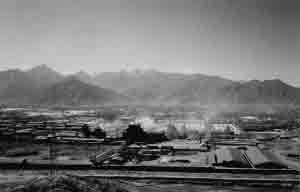Drapchi Prison on:
[Wikipedia]
[Google]
[Amazon]


 Drapchi Prison, or Lhasa Prison No. 1 (, lit. "four corners"; ), is the largest prison in
Drapchi Prison, or Lhasa Prison No. 1 (, lit. "four corners"; ), is the largest prison in
History of Drapchi Prison
Buildings and structures in Lhasa Prisons in China {{PRChina-prison-stub


 Drapchi Prison, or Lhasa Prison No. 1 (, lit. "four corners"; ), is the largest prison in
Drapchi Prison, or Lhasa Prison No. 1 (, lit. "four corners"; ), is the largest prison in Tibet
Tibet (; ''Böd''; ), or Greater Tibet, is a region in the western part of East Asia, covering much of the Tibetan Plateau and spanning about . It is the homeland of the Tibetan people. Also resident on the plateau are other ethnic groups s ...
, China
China, officially the People's Republic of China (PRC), is a country in East Asia. With population of China, a population exceeding 1.4 billion, it is the list of countries by population (United Nations), second-most populous country after ...
, located in Lhasa
Lhasa, officially the Chengguan District of Lhasa City, is the inner urban district of Lhasa (city), Lhasa City, Tibet Autonomous Region, Southwestern China.
Lhasa is the second most populous urban area on the Tibetan Plateau after Xining ...
. Drapchi is named after its location and was originally a military garrison until it was converted into a prison after the 1959 Tibetan Uprising. It is roughly one mile from the city centre and is the main prison for judicially sentenced prisoners in Tibet. It was the primary place for the detention of political prisoners before 2005 when the newer and modernised Chushur (Chinese: Qushui) Prison was built. Drapchi also goes by the name Delapuxie prison, which has sometimes been listed as a separate prison online.
According to Central Tibetan Administration, the prison has gained a notorious reputation and is feared by the Tibetans due to its strong management. Reports of brutality have been alleged by Tibetan exile groups.
In November 1994, 13 nuns were sent to Drapchi to serve a 5-year sentence for endangering state security by protests against the Chinese rule in Lhasa. In April 1996, all the inmates of Unit 3 of Drapchi prison, consisting of nearly 100 female political prisoners, went on a hunger strike in protest of their treatment. The week-long strike caused the prison officers some concern that it might damage the reputation of the prison further if the inmates died as a result and promised an end to the brutality.
Drapchi Prison used to be the only official prison in Tibet but, following the 1994 law change, former laogais were rebranded, and locations such as Powo Tramo were also referred to as prisons.
China claims that "The Tibet Autonomous Region Prison aims to create a "modern and civilised prison". According to the same source, between 1997 and 2004, it had invested "more than 60 million yuan in the construction of software and hardware facilities, which has improved the overall appearance of the prison".
See also
*Lhasa
Lhasa, officially the Chengguan District of Lhasa City, is the inner urban district of Lhasa (city), Lhasa City, Tibet Autonomous Region, Southwestern China.
Lhasa is the second most populous urban area on the Tibetan Plateau after Xining ...
* Tibetan Money
* Army of Tibet
* Tsarong
* Human Rights in Tibet
Human rights in Tibet has been a subject of intense international scrutiny and debate, particularly since the annexation of Tibet by the People's Republic of China. Before the 1950s, Tibet's social structure was marked by inequality and described a ...
* Tibet since 1950
* Central Tibetan Administration
* Ganden Phodrang
The Ganden Phodrang or Ganden Podrang (; ) was the Tibetan system of government established by the 5th Dalai Lama in 1642, when the Oirat lord Güshi Khan who founded the Khoshut Khanate conferred all spiritual and political power in Tibet t ...
* Tenzin Gyatso, the 14th Dalai Lama
References
External links
*History of Drapchi Prison
Buildings and structures in Lhasa Prisons in China {{PRChina-prison-stub